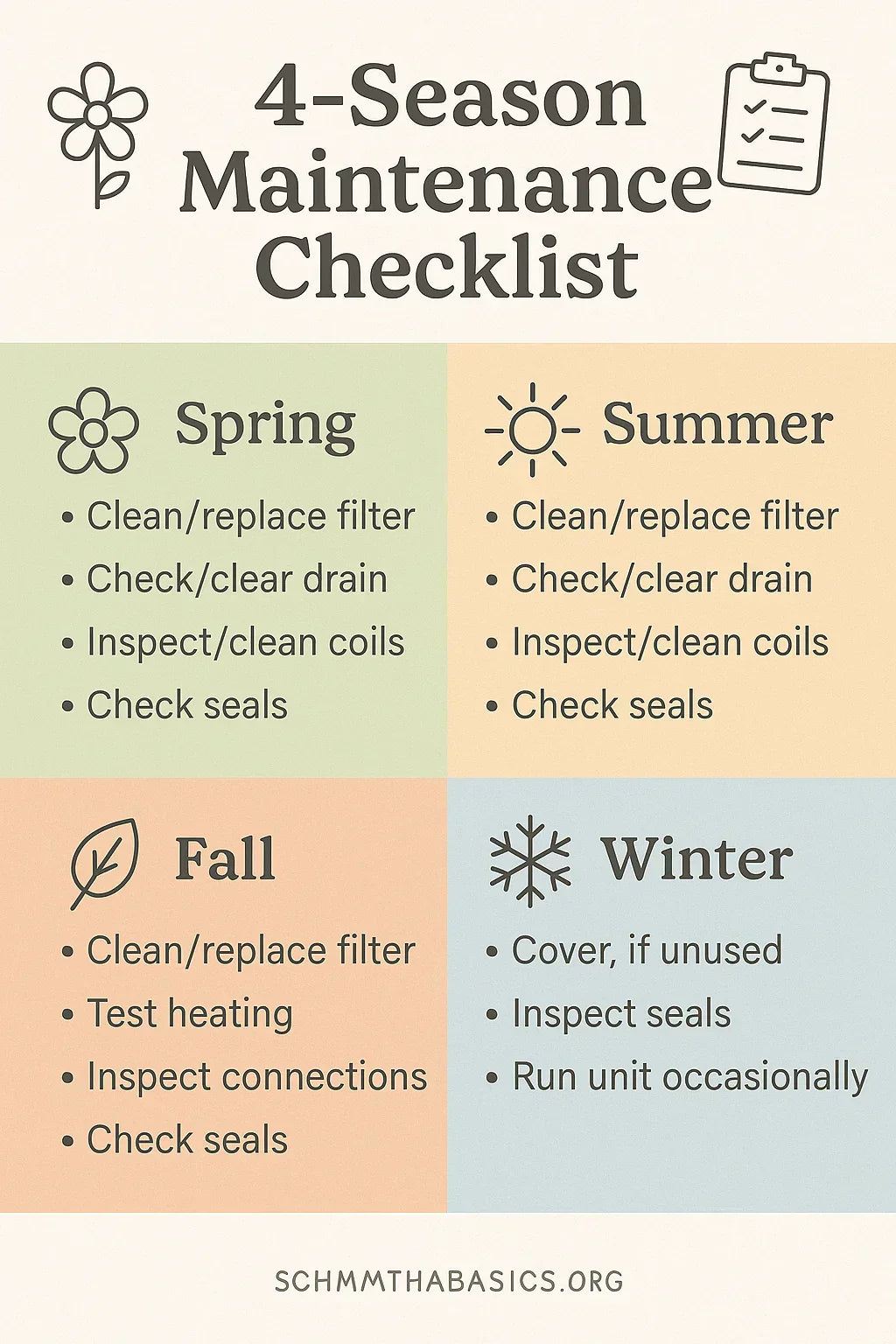When you invest in a heating and cooling unit—whether it’s an Amana, GE, or Hotpoint model—you want it to last. But here’s the truth: even the best unit can lose efficiency, develop leaks, or fail early if you skip maintenance.
That’s why I’ve put together this step-by-step checklist to help you keep your system running smoothly. Think of it as your year-round playbook for filters, drains, coils, and seasonal care. With a little DIY attention, you can save money, extend your unit’s lifespan, and avoid those dreaded “why isn’t this cooling/heating?” moments.
🌀 Why Maintenance Matters
Before we dive into filters and drains, let’s talk about why this matters:
-
Efficiency – A dirty filter alone can increase energy use by 15% .
-
Air Quality – Dusty filters = dusty air in your home.
-
Longevity – Units that get seasonal care often last 2–4 years longer.
-
Fewer Repairs – Preventative cleaning helps avoid clogged drains, iced-over coils, and overheating.
👉 The U.S. Department of Energy emphasizes regular HVAC maintenance as one of the top ways to save on energy bills .
🧽 Step 1: Filter Care
The filter is your unit’s first line of defense.
🔴 Amana
-
Many Amana models use washable, reusable filters.
-
Monthly check recommended; rinse under warm water and let dry completely before reinstalling.
-
Replace every 1–2 years if wear or damage is visible.
🔵 GE
-
GE units often include smart filter reminders that alert you when cleaning is needed.
-
Clean or replace every 30–60 days, depending on use.
-
Filters are widely available and inexpensive.
⚪ Hotpoint
-
Hotpoint units typically use basic slide-out filters.
-
These need the most attention—monthly cleaning is essential.
-
Replace yearly for best airflow.
👉 Learn more at EnergyStar Filter Guidance.
💧 Step 2: Drain Maintenance
When your unit cools, it creates condensation. If the drains clog, you could face leaks or even mold.
-
Monthly: Check the drain pan (under the unit) for standing water.
-
Quarterly: Use a pipe cleaner or brush to keep the drain line clear.
-
Pro Tip: Pour a small amount of diluted vinegar through the line to kill bacteria.
Brand Notes
-
Amana – Heavier-duty drain pans; less prone to clogs but still need checks.
-
GE – Many units have angled drain designs for better flow.
-
Hotpoint – Smaller pans; more frequent checks are necessary.
👉 See the DOE’s AC Maintenance Tips for more on drain line care.
🌀 Step 3: Coil Cleaning
Both the evaporator coil (inside) and the condenser coil (outside) can collect dirt and reduce efficiency.
-
Annually: Vacuum coils with a brush attachment.
-
Every 2–3 years: Have a pro do a deep chemical clean if buildup is heavy.
Brand Notes
-
Amana – Coil access panels are well-designed, making DIY cleaning easier.
-
GE – Often comes with coated coils for corrosion resistance.
-
Hotpoint – Simpler coil designs, but more prone to dirt buildup.
👉 Read Amana’s maintenance guides for coil access instructions.
🗓️ Seasonal Checklist
Here’s the year-round care routine I recommend:
🏖️ Spring & Summer (Cooling Season)
-
Clean or replace filters.
-
Check and clear drains.
-
Inspect and clean coils.
-
Ensure the wall sleeve and seals are tight—no drafts.
🍂 Fall (Heating Prep)
-
Switch the unit to heat mode (if it’s a heat pump or has electric heat).
-
Test for unusual smells (burning dust is normal at first).
-
Inspect electrical connections.
❄️ Winter
-
For units not in use, cover the exterior grille with a breathable cover.
-
Inspect seals to prevent drafts.
-
Run the unit occasionally to keep parts moving.
🌸 Early Spring
-
Remove winter covers.
-
Do a full inspection before heavy use.
-
Check smart alerts on GE models.
👉 Download the EnergyStar seasonal maintenance checklist for more details.
🛠️ DIY vs. Professional Care
✅ DIY Tasks
-
Filters (monthly)
-
Drain checks (monthly/quarterly)
-
Coil vacuuming (annually)
-
Seal inspection (seasonally)
🚫 Professional Tasks
-
Deep coil cleaning
-
Electrical inspections
-
Refrigerant issues
-
Persistent drainage problems
👉 When in doubt, call a certified HVAC technician. Find one via ACCA.
🔎 Brand-Specific Maintenance Insights
Amana
-
Best-in-class warranties mean it’s worth maintaining properly.
-
Strong build = fewer emergency repairs.
GE
-
Smart features (like filter alerts) make maintenance easier.
-
Designed for heavy, commercial-style use.
Hotpoint
-
Lower upfront cost, but needs consistent care to avoid early failure.
-
Easy to service thanks to simpler design.
📊 Cost of Skipping Maintenance
Let’s compare:
| Maintenance Level | Energy Cost Impact | Lifespan Impact | Repair Risk |
|---|---|---|---|
| Regular (monthly) | Baseline | Full lifespan (10–15 years) | Low |
| Minimal (annual only) | +15–20% bills | 7–10 years | Medium |
| None | +30% bills | 5–7 years | High |
👉 Skipping filter care alone could cost you hundreds annually in wasted energy .
📝 Samantha’s Final Thoughts
If you take one thing away from this: maintenance pays for itself.
-
Amana rewards you with longevity if you stay on top of simple care.
-
GE helps you with smart reminders—but you still have to act on them.
-
Hotpoint demands attention, but with a little consistency, it can serve well for years.
So grab your calendar, mark down monthly filter checks, and commit to a seasonal walk-through. Your Amana, GE, or Hotpoint unit (and your energy bills) will thank you.
In the next topic we will know more about: Do Amana, GE & Hotpoint Units Qualify for Energy Rebates or Tax Credits in 2025?







